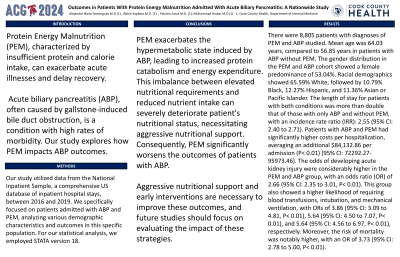Tuesday Poster Session
Category: Biliary/Pancreas
P3435 - Outcomes in Patients With Protein Energy Malnutrition Admitted With Acute Biliary Pancreatitis: A Nationwide Study
Tuesday, October 29, 2024
10:30 AM - 4:00 PM ET
Location: Exhibit Hall E


Alejandro J. Nieto Dominguez, MD
John H. Stroger, Jr. Hospital of Cook County
Chicago, IL
Presenting Author(s)
Alejandro J. Nieto Dominguez, MD, Abhin Sapkota, MD, Patricia Zarza, MD, Muhammad Tayyab Anwar, MD
John H. Stroger, Jr. Hospital of Cook County, Chicago, IL
Introduction: Protein Energy Malnutrition (PEM), characterized by insufficient protein and calorie intake, can exacerbate acute illnesses and delay recovery. Acute biliary pancreatitis (ABP), often caused by gallstone-induced bile duct obstruction, is a condition with high rates of morbidity. Our study explores how PEM impacts ABP outcomes.
Methods: Our study utilized data from the National Inpatient Sample, a comprehensive US database of inpatient hospital stays, between 2016 and 2019. We specifically focused on patients admitted with ABP and PEM, analyzing various demographic characteristics and outcomes in this specific population. For our statistical analysis, we employed STATA version 18.
Results: There were 8,805 patients with diagnoses of PEM and ABP studied. Mean age was 64.03 years, compared to 56.85 years in patients with ABP without PEM. The gender distribution in the PEM and ABP cohort showed a female predominance of 53.04%. Racial demographics showed 65.59% White, followed by 10.79% Black, 12.27% Hispanic, and 11.36% Asian or Pacific Islander. The length of stay for patients with both conditions was more than double that of those with only ABP and without PEM, with an incidence rate ratio (IRR): 2.55 (95% CI: 2.40 to 2.71). Patients with ABP and PEM had significantly higher costs per hospitalization, averaging an additional $84,132.86 per admission (P< 0.01) (95% CI: 72292.27-95973.46). The odds of developing acute kidney injury were considerably higher in the PEM and ABP group, with an odds ratio (OR) of 2.66 (95% CI: 2.35 to 3.01, P< 0.01). This group also showed a higher likelihood of requiring blood transfusions, intubation, and mechanical ventilation, with ORs of 3.86 (95% CI: 3.09 to 4.81, P< 0.01), 5.64 (95% CI: 4.50 to 7.07, P< 0.01), and 5.64 (95% CI: 4.56 to 6.97, P< 0.01), respectively. Moreover, the risk of mortality was notably higher, with an OR of 3.73 (95% CI: 2.78 to 5.00, P< 0.01).
Discussion: PEM exacerbates the hypermetabolic state induced by ABP, leading to increased protein catabolism and energy expenditure. This imbalance between elevated nutritional requirements and reduced nutrient intake can severely deteriorate patient's nutritional status, necessitating aggressive nutritional support. Consequently, PEM significantly worsens the outcomes of patients with ABP. Aggressive nutritional support and early interventions are necessary to improve these outcomes, and future studies should focus on evaluating the impact of these strategies.
Disclosures:
Alejandro J. Nieto Dominguez, MD, Abhin Sapkota, MD, Patricia Zarza, MD, Muhammad Tayyab Anwar, MD. P3435 - Outcomes in Patients With Protein Energy Malnutrition Admitted With Acute Biliary Pancreatitis: A Nationwide Study, ACG 2024 Annual Scientific Meeting Abstracts. Philadelphia, PA: American College of Gastroenterology.
John H. Stroger, Jr. Hospital of Cook County, Chicago, IL
Introduction: Protein Energy Malnutrition (PEM), characterized by insufficient protein and calorie intake, can exacerbate acute illnesses and delay recovery. Acute biliary pancreatitis (ABP), often caused by gallstone-induced bile duct obstruction, is a condition with high rates of morbidity. Our study explores how PEM impacts ABP outcomes.
Methods: Our study utilized data from the National Inpatient Sample, a comprehensive US database of inpatient hospital stays, between 2016 and 2019. We specifically focused on patients admitted with ABP and PEM, analyzing various demographic characteristics and outcomes in this specific population. For our statistical analysis, we employed STATA version 18.
Results: There were 8,805 patients with diagnoses of PEM and ABP studied. Mean age was 64.03 years, compared to 56.85 years in patients with ABP without PEM. The gender distribution in the PEM and ABP cohort showed a female predominance of 53.04%. Racial demographics showed 65.59% White, followed by 10.79% Black, 12.27% Hispanic, and 11.36% Asian or Pacific Islander. The length of stay for patients with both conditions was more than double that of those with only ABP and without PEM, with an incidence rate ratio (IRR): 2.55 (95% CI: 2.40 to 2.71). Patients with ABP and PEM had significantly higher costs per hospitalization, averaging an additional $84,132.86 per admission (P< 0.01) (95% CI: 72292.27-95973.46). The odds of developing acute kidney injury were considerably higher in the PEM and ABP group, with an odds ratio (OR) of 2.66 (95% CI: 2.35 to 3.01, P< 0.01). This group also showed a higher likelihood of requiring blood transfusions, intubation, and mechanical ventilation, with ORs of 3.86 (95% CI: 3.09 to 4.81, P< 0.01), 5.64 (95% CI: 4.50 to 7.07, P< 0.01), and 5.64 (95% CI: 4.56 to 6.97, P< 0.01), respectively. Moreover, the risk of mortality was notably higher, with an OR of 3.73 (95% CI: 2.78 to 5.00, P< 0.01).
Discussion: PEM exacerbates the hypermetabolic state induced by ABP, leading to increased protein catabolism and energy expenditure. This imbalance between elevated nutritional requirements and reduced nutrient intake can severely deteriorate patient's nutritional status, necessitating aggressive nutritional support. Consequently, PEM significantly worsens the outcomes of patients with ABP. Aggressive nutritional support and early interventions are necessary to improve these outcomes, and future studies should focus on evaluating the impact of these strategies.
Disclosures:
Alejandro Nieto Dominguez indicated no relevant financial relationships.
Abhin Sapkota indicated no relevant financial relationships.
Patricia Zarza indicated no relevant financial relationships.
Muhammad Tayyab Anwar indicated no relevant financial relationships.
Alejandro J. Nieto Dominguez, MD, Abhin Sapkota, MD, Patricia Zarza, MD, Muhammad Tayyab Anwar, MD. P3435 - Outcomes in Patients With Protein Energy Malnutrition Admitted With Acute Biliary Pancreatitis: A Nationwide Study, ACG 2024 Annual Scientific Meeting Abstracts. Philadelphia, PA: American College of Gastroenterology.
